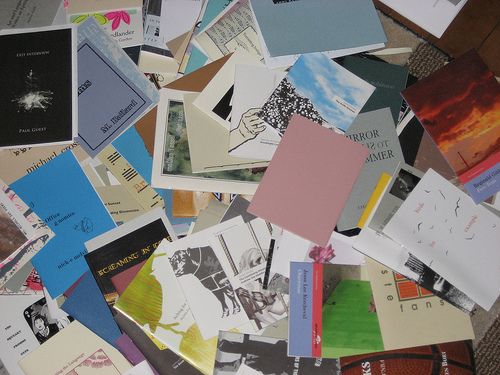 |
| Miscellaneous chapbooks |
I'm delighted to announce that I'll be the Aggregate Space Writer-In-Residence this summer. I'm honored to be the first participant in the artist-run space's new program and I'm looking forward to my time in West Oakland! (For readers unfamiliar with Aggregate Space, I recommend reading Kelly Inouye's interview with Conrad Meyers II and SD Willis in SFAQ. As Inoyue writes, Meyers and Willis "basically created a gallery, artist studios, metal and wood fabrication shop, small theater, and office space out of an empty warehouse.")
During the residency, I'll consider "Cinderscape," artist Jaime Lakatos' solo show at Aggregate Space (which will be on view during my tenure), and will post my reflections here on HH. Per the residency's requirement, I will also be producing a chapbook; in fact, I plan to create two.
For readers unfamiliar with chapbooks, the term is defined by the American Heritage Dictionary (4th Edition) as "a small book or pamphlet containing poems, ballads, stories, or religious tracts." As writer Marko Fong explains in a short essay about the history of the form,
"If an ordinary person in the 16th century wanted to share a broadside, a ballad, poems, nursery rhymes, or stories, the options were limited. Alongside the printers who produced those King James Bibles with the gold-leaf edging, leather covers, hand-stitched bindings, and smear-free ink, a 'people’s' medium for publication emerged that,When I hear the term, I think of the American Revolution. In particular, I think of the ideologue and rabble-rouser Thomas Paine. (Paine's famous populist manifesto, Common Sense, is generally described as a pamphlet, but the distinction between chapbooks and pamphlets is nominal.) So what's the contemporary analogue of Common Sense?
- Didn’t have a binding or hard cover
- Was made by folding sheets of low-quality paper multiple times (32 pages or 5 folds came from this tradition) and was physically smaller than a printed book
- Used quick-inexpensive production and printing techniques (illustration was limited to simple woodcuts) with low quality ink on cheap paper. [...]
These were 'chapbooks.' The Middle English word for 'cheap' was 'ceap.' They sold for anywhere from two to twelve pence a copy and instead of being sold through booksellers were distributed in pubs, on street corners, at markets, and other public gatherings by a new sort of peddler called a 'chapman.' The form became phenomenally successful. Because few examples of early chapbooks survive, we forget how much more prolific the chapbook publishing industry was than its bound-book brother."
The enthusiasm for zines and literary chapbooks in some cultural corners is noteworthy (maybe even growing), but not far-flung, and I don't think there's a printed heir apparent. For over a decade, however, commentators have cast blogs in that role. I used to reject the comparison because chapbooks are generally associated with inexpensive distribution whereas blogging and blog reading require investment in expensive hardware and Internet service subscriptions. Nevertheless, my thinking has evolved. Recent Pew data suggests that over 75% of the United States' population owns a desktop or laptop computer and between 25-30% own e-book readers and/or tablets. As computers continue to become more affordable and Internet access becomes ubiquitous (here and abroad), digital content will become increasingly accessible. Twitter and other social media platforms are often mentioned in the context of the "Arab Spring," but blogs also played their part in the revolutionary wave that surged (and continues to surge) through the Arab world. It's therefore reasonable to describe some of the Egyptian bloggers as latter-day Thomas Paines (with respect to their roles as inciters and chroniclers of revolution, at least; they'd be hard pressed to equal Paine as a writer).
I have more modest aspirations; the two chapbooks I plan to produce while at Aggregate Space will not foment revolution. I'm merely interested in using the residency as an opportunity to experiment with a form new to me. I want to create two digital chapbooks that can be freely distributed online, but are formatted especially for reading on tablets and e-book readers. Both will be heavy on photographs and text, and I may incorporate video, if relevant. One of the two projects will sample from my old commonplace books, a cousin of the chapbook and a form of journaling that should be fun to document and celebrate. The second chapbook will explore my relationship to and experiences with the killing of other animals; it will likely include a series of vignettes from my childhood as well as photos taken by my father (during the 1970s and 1980s) and me.
More details as the project moves forward.
Image credit: photograph ripped from The Center for Book Arts website

No comments:
Post a Comment